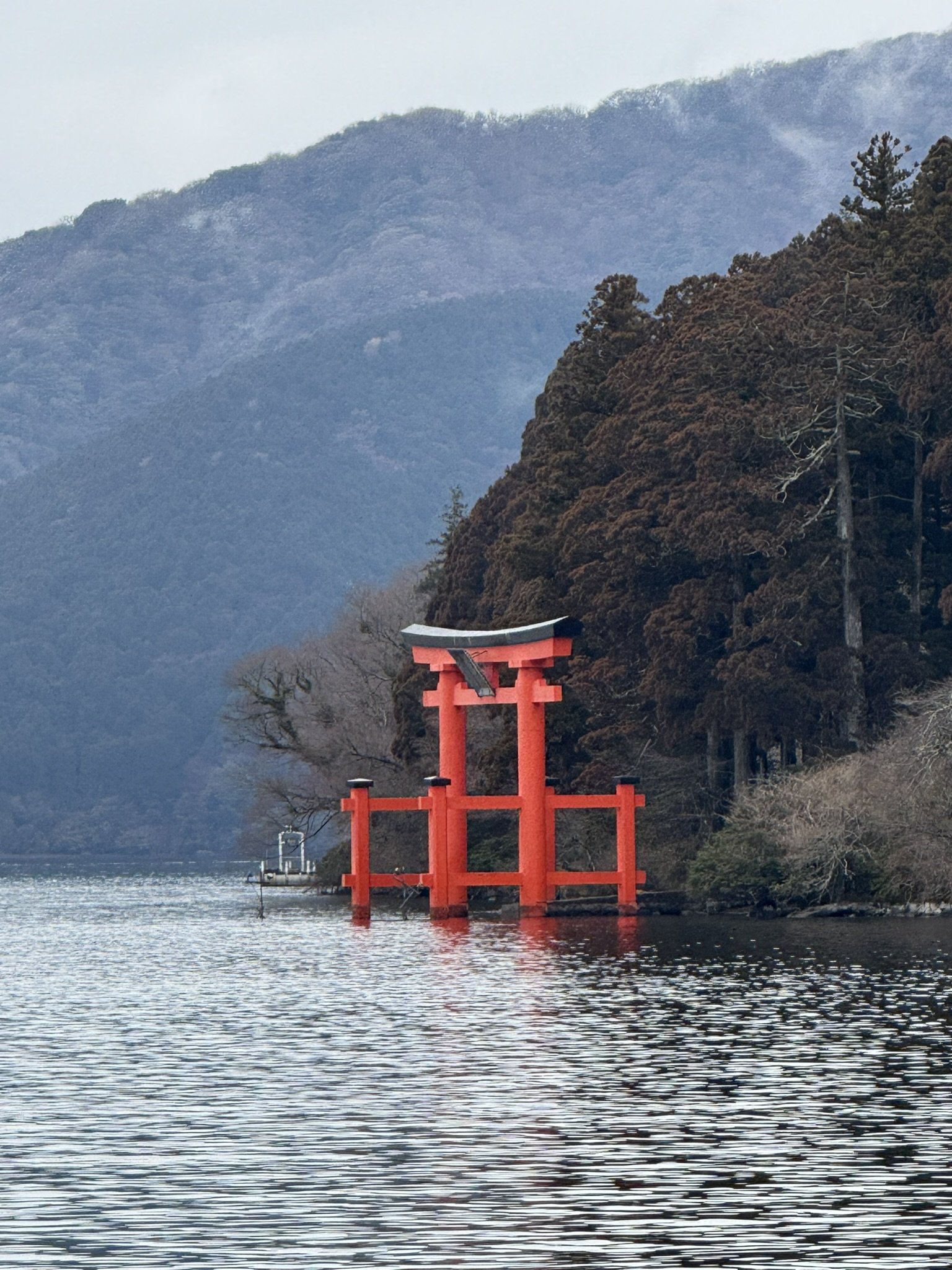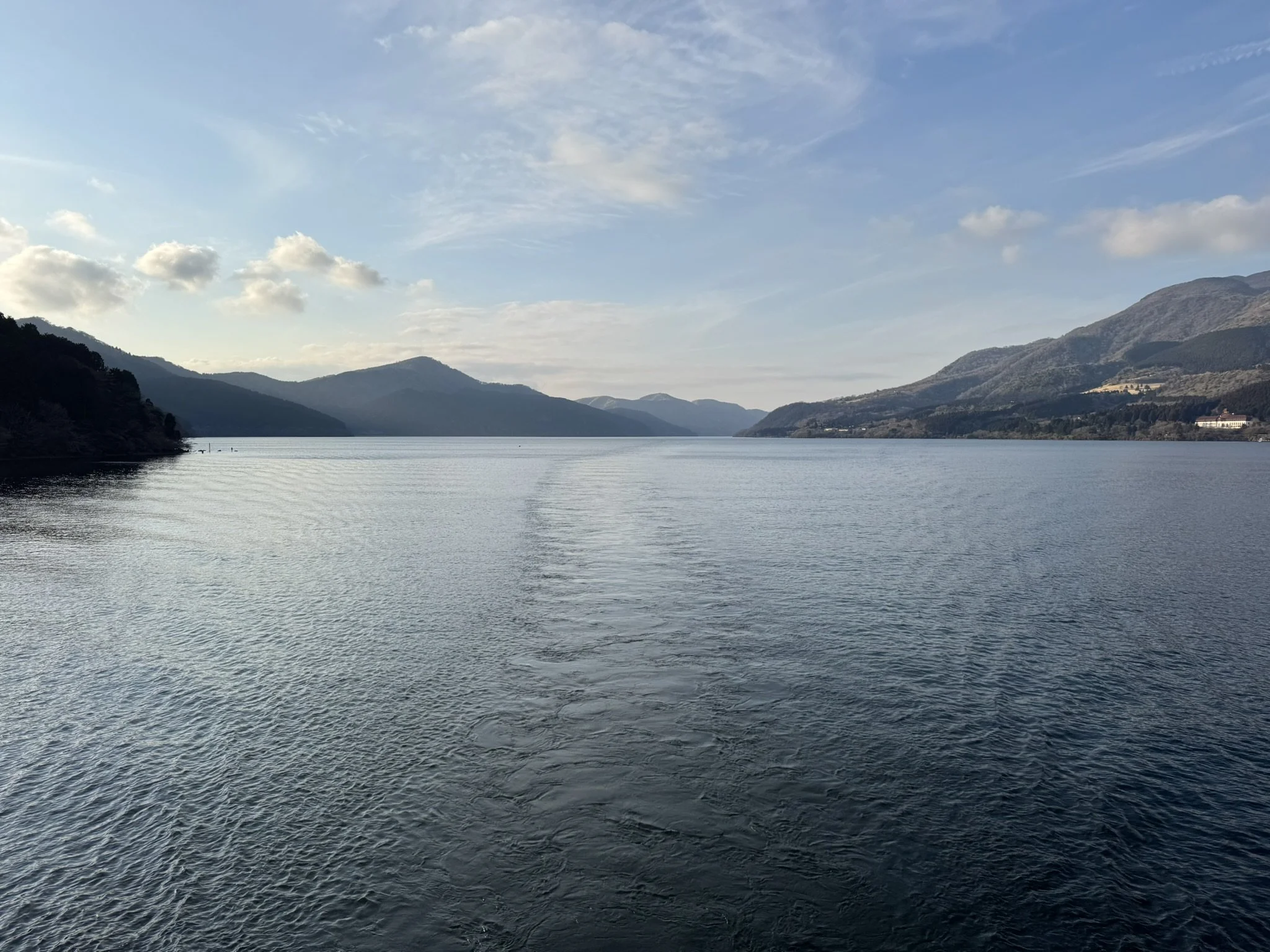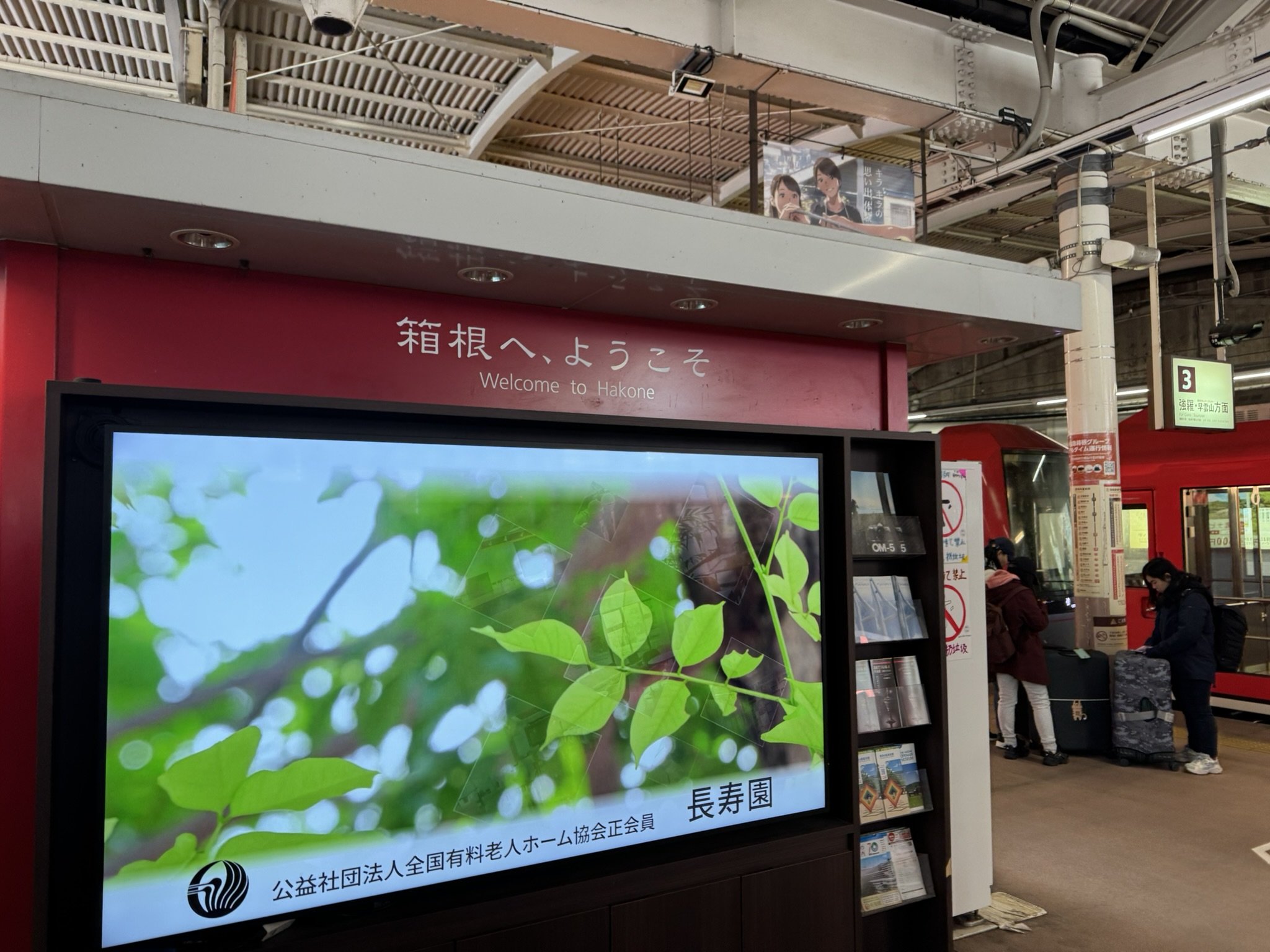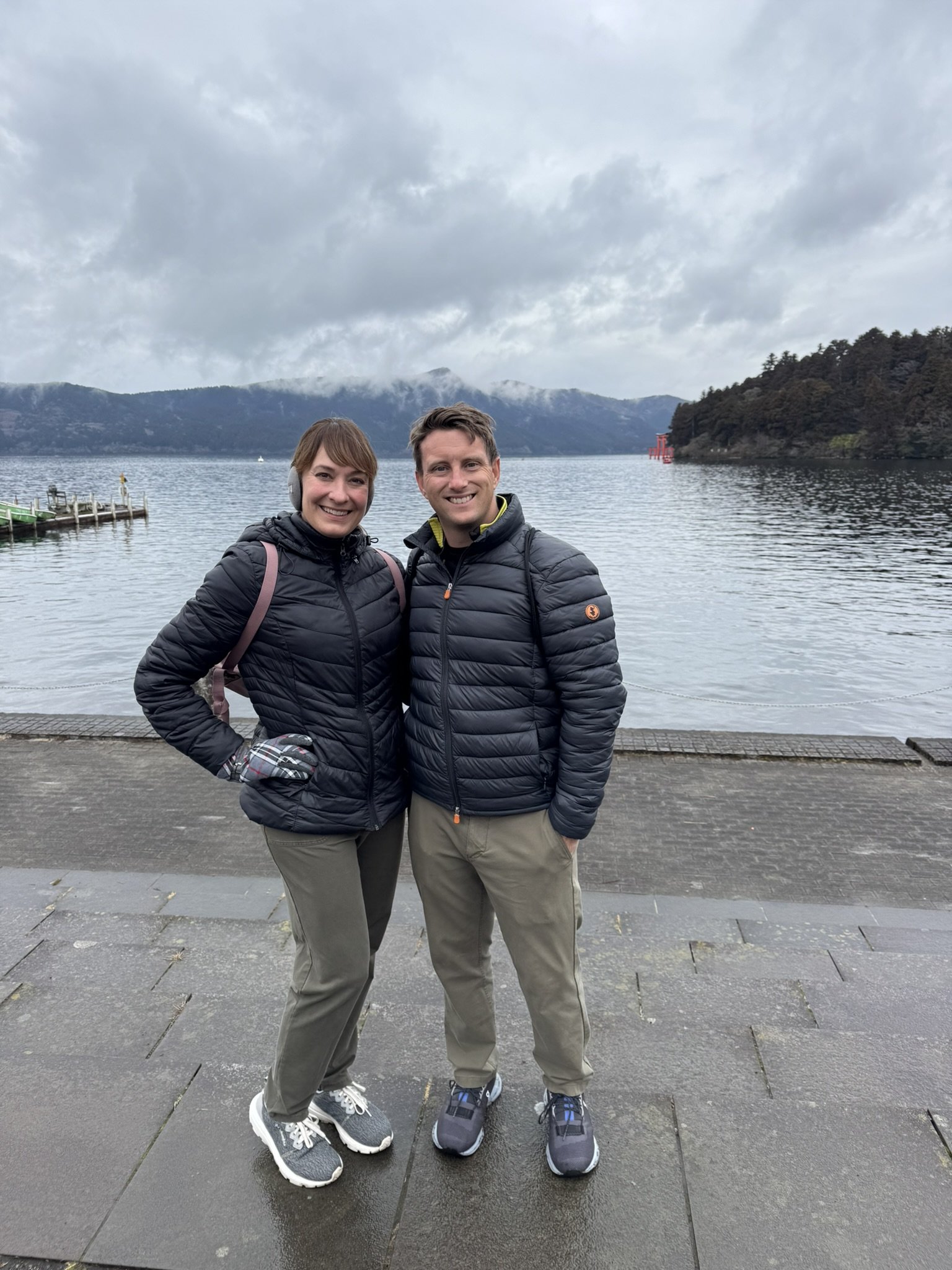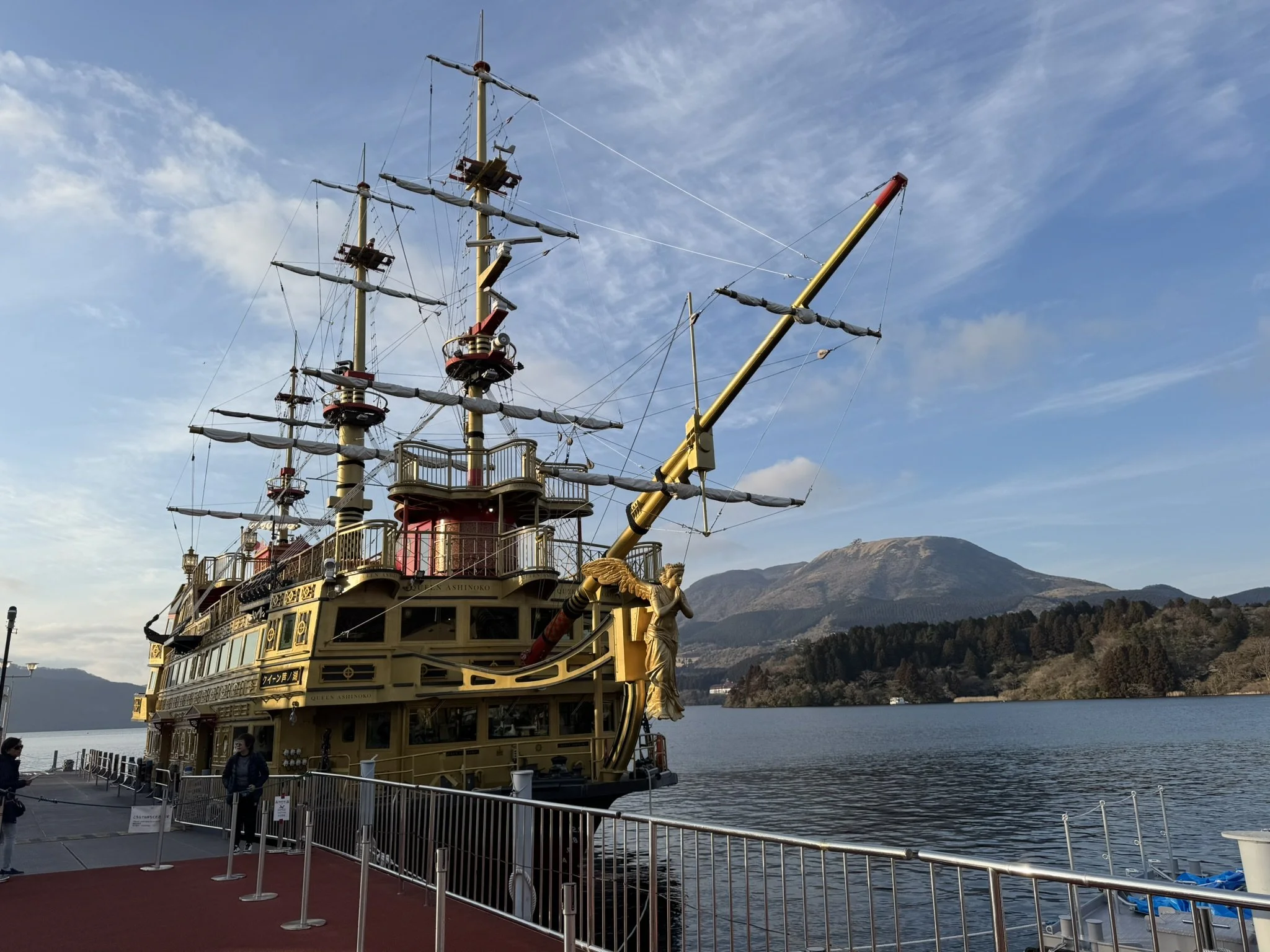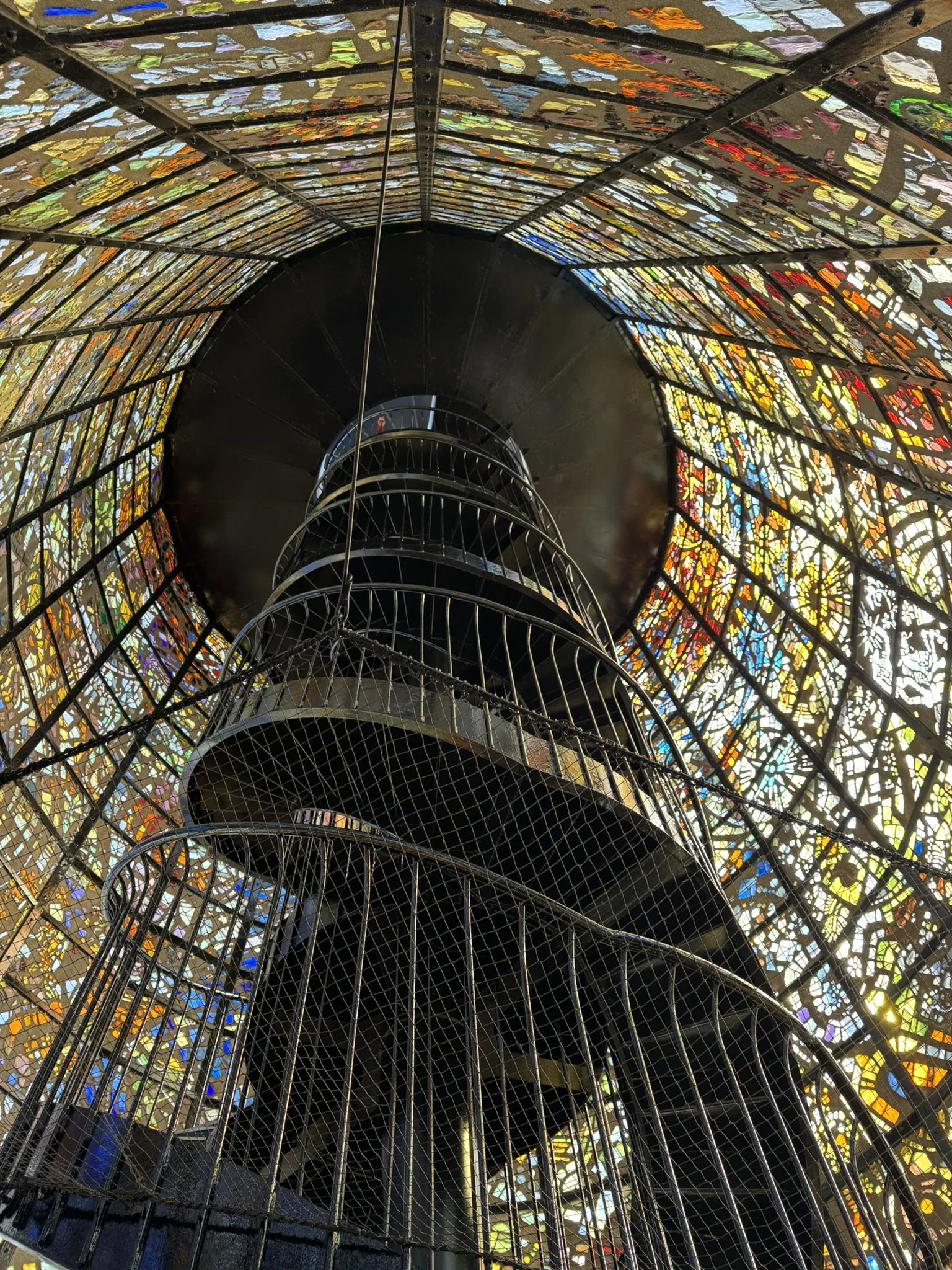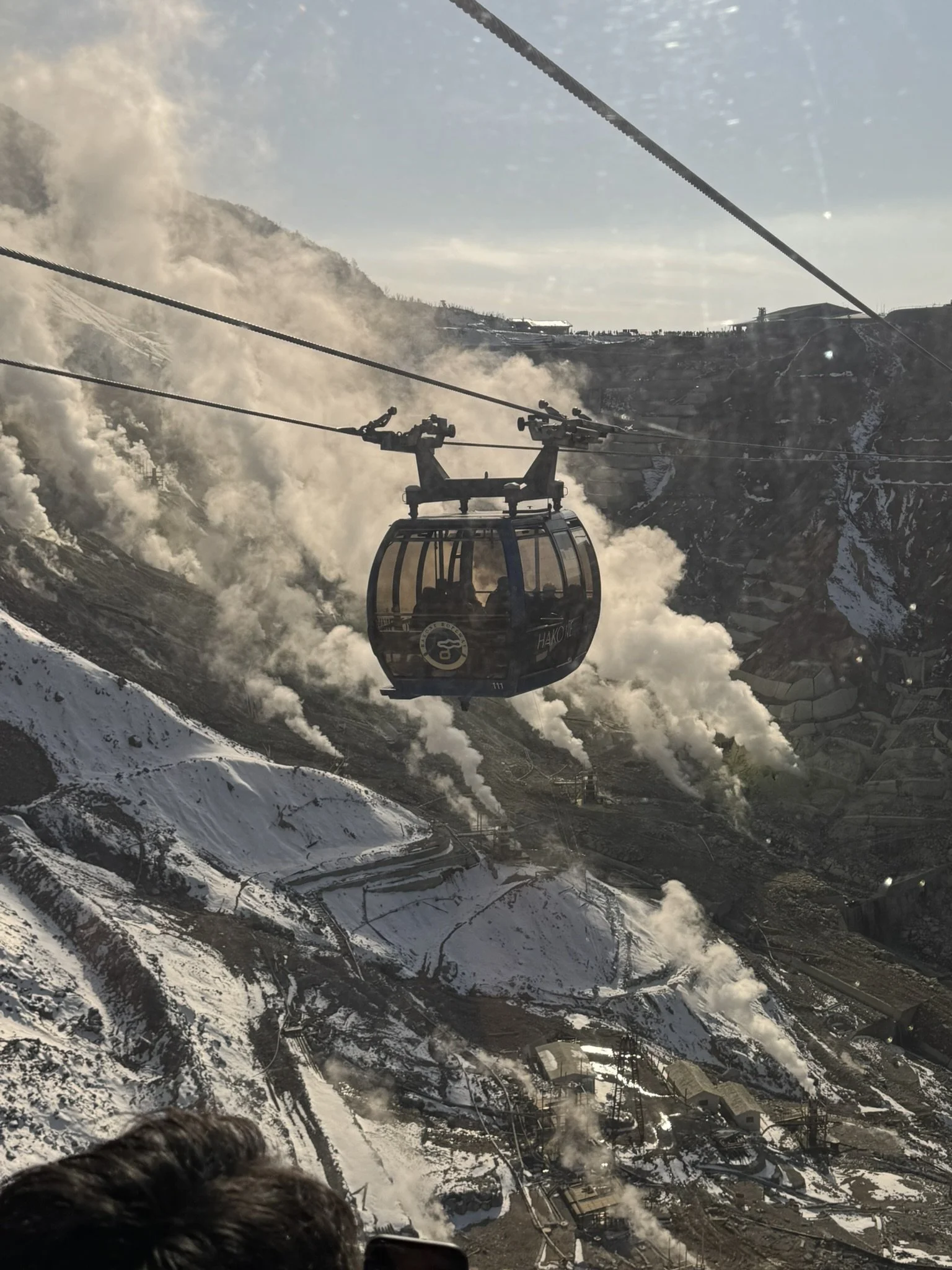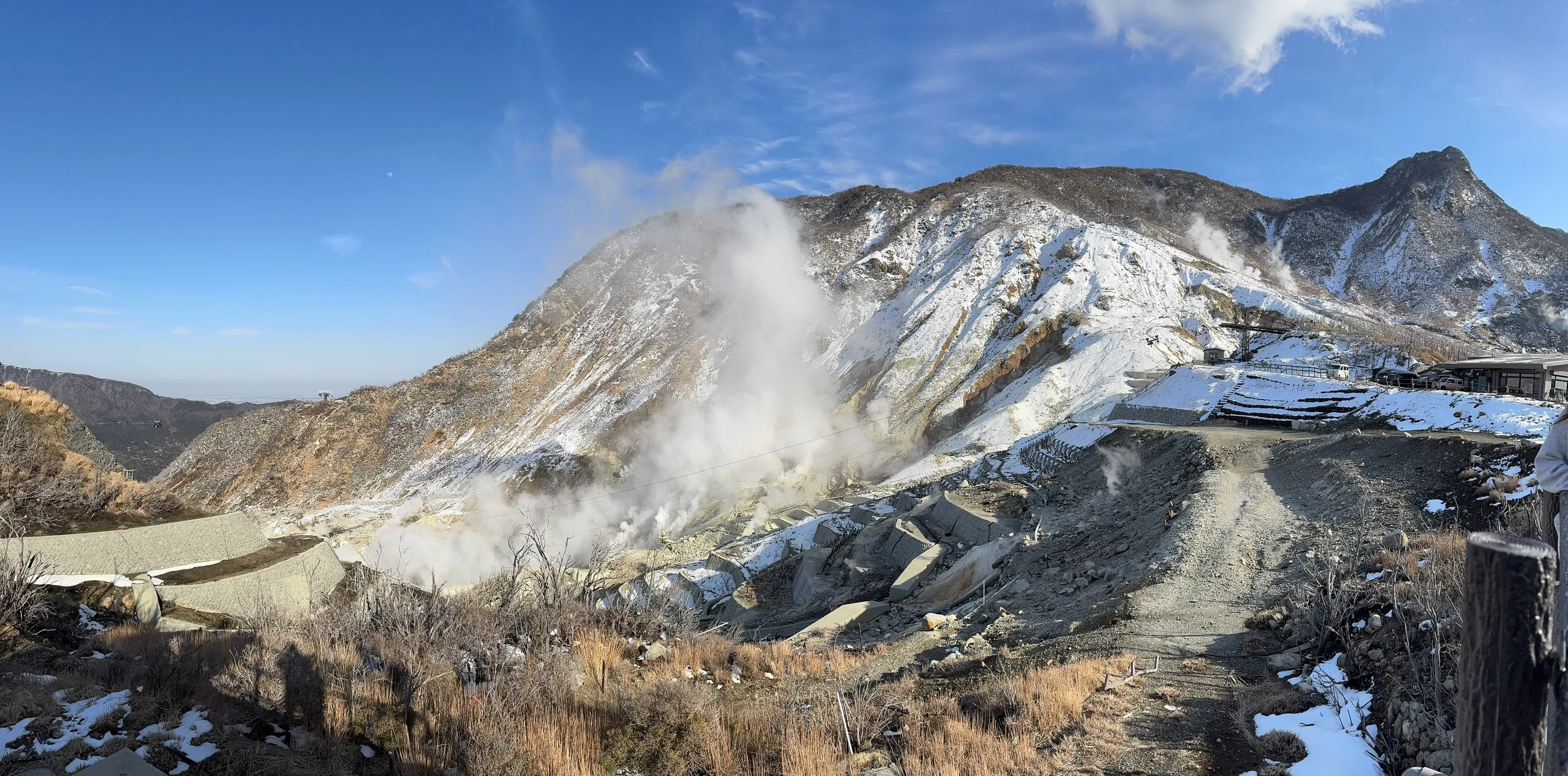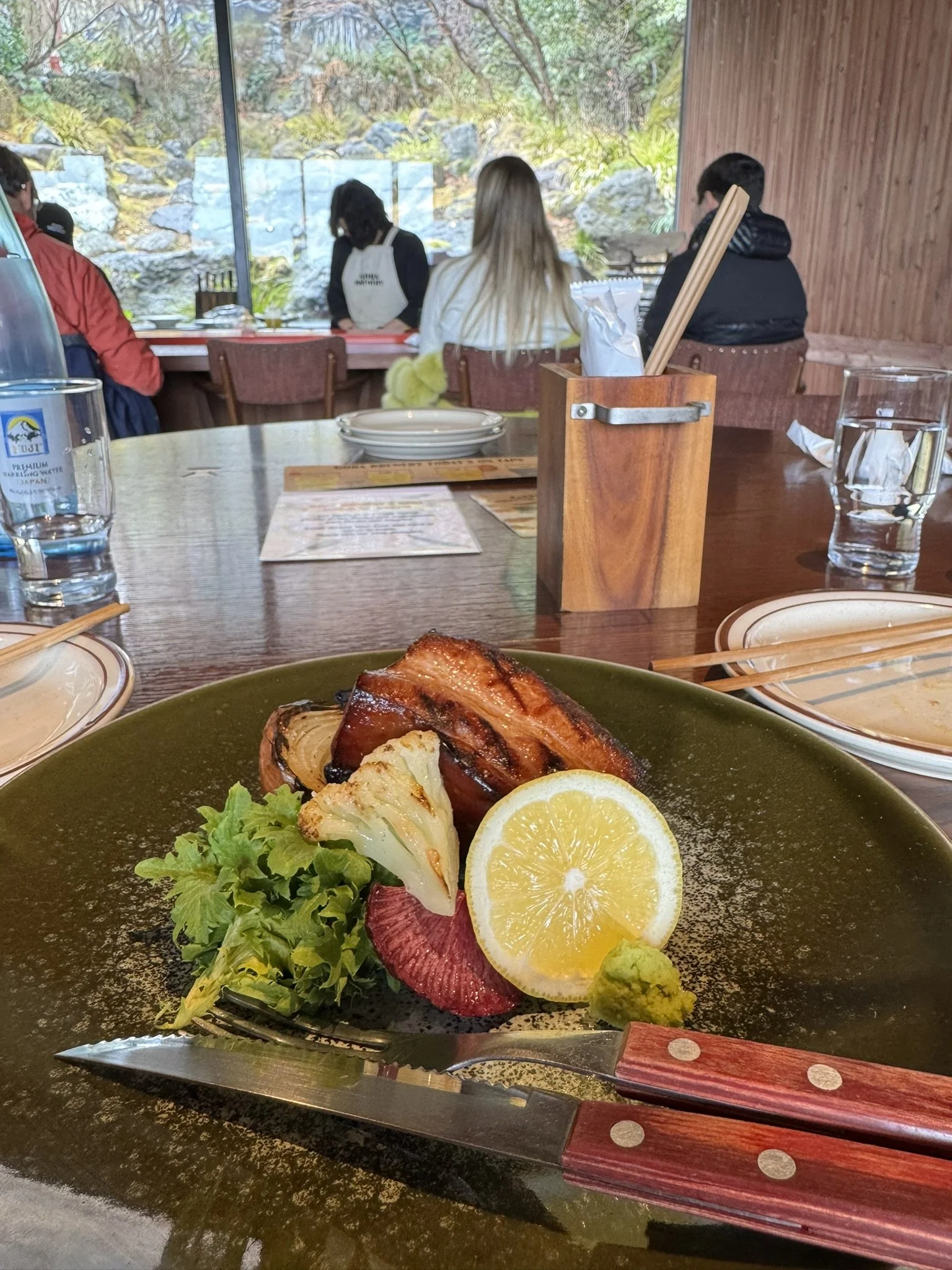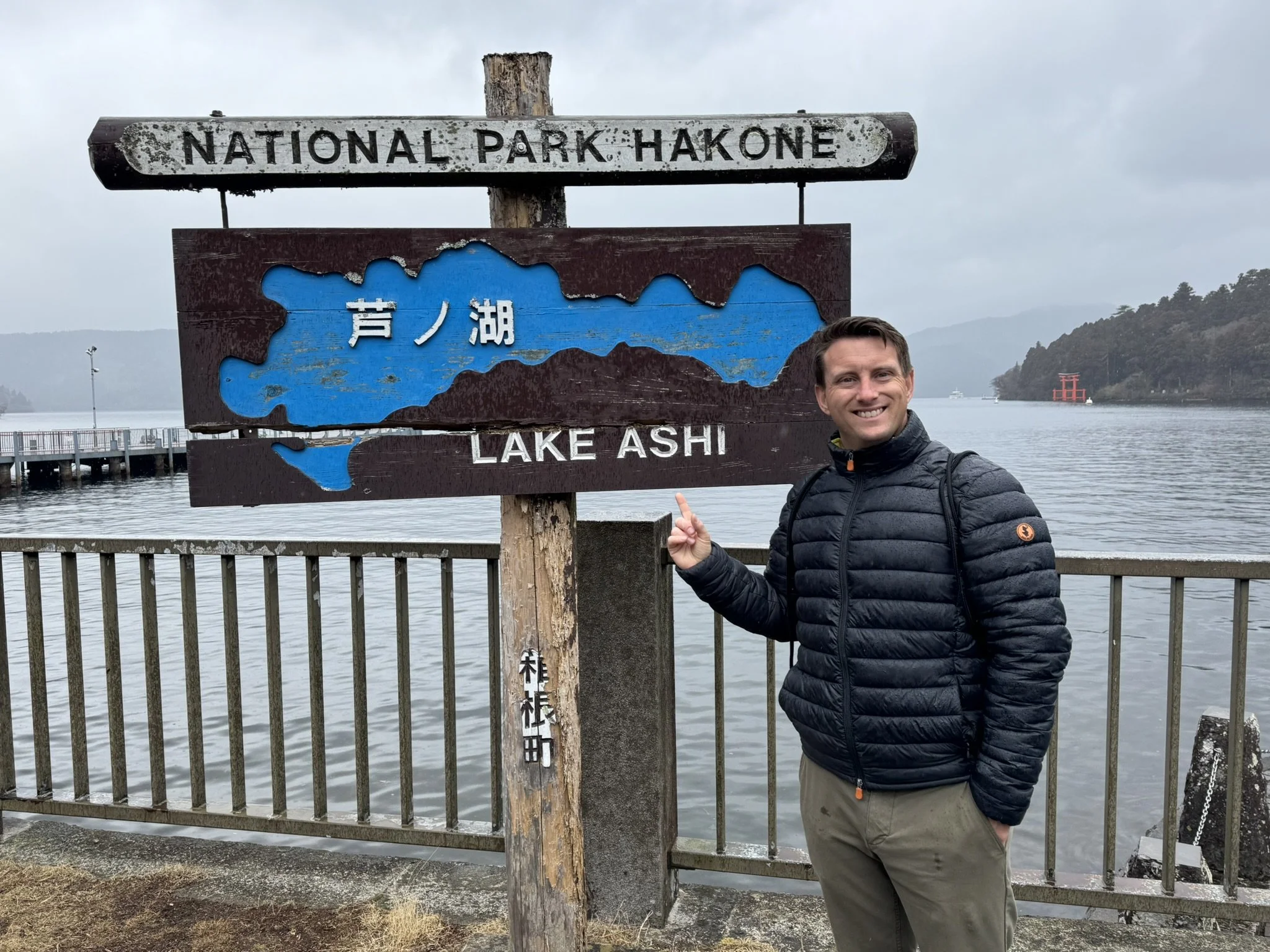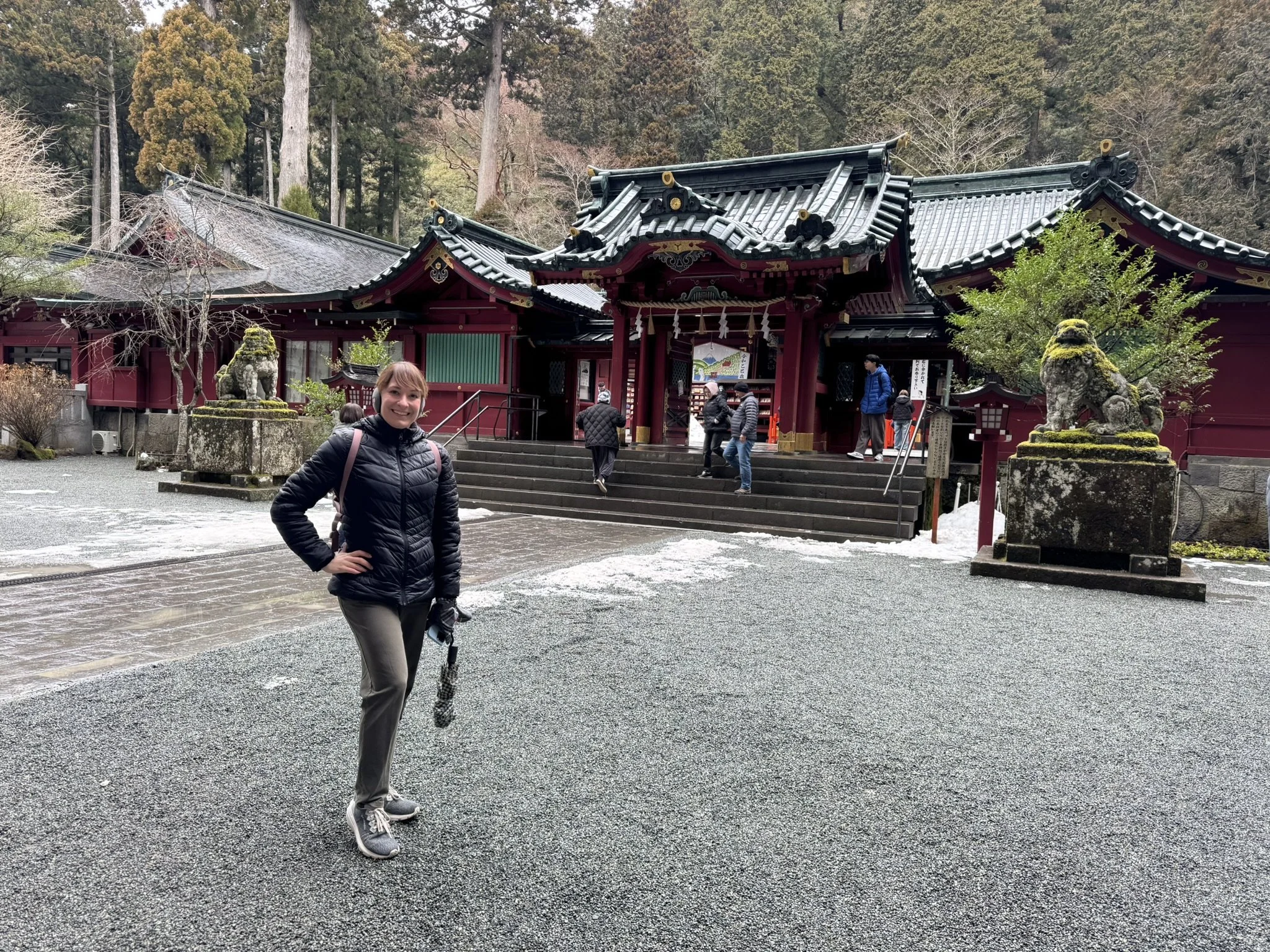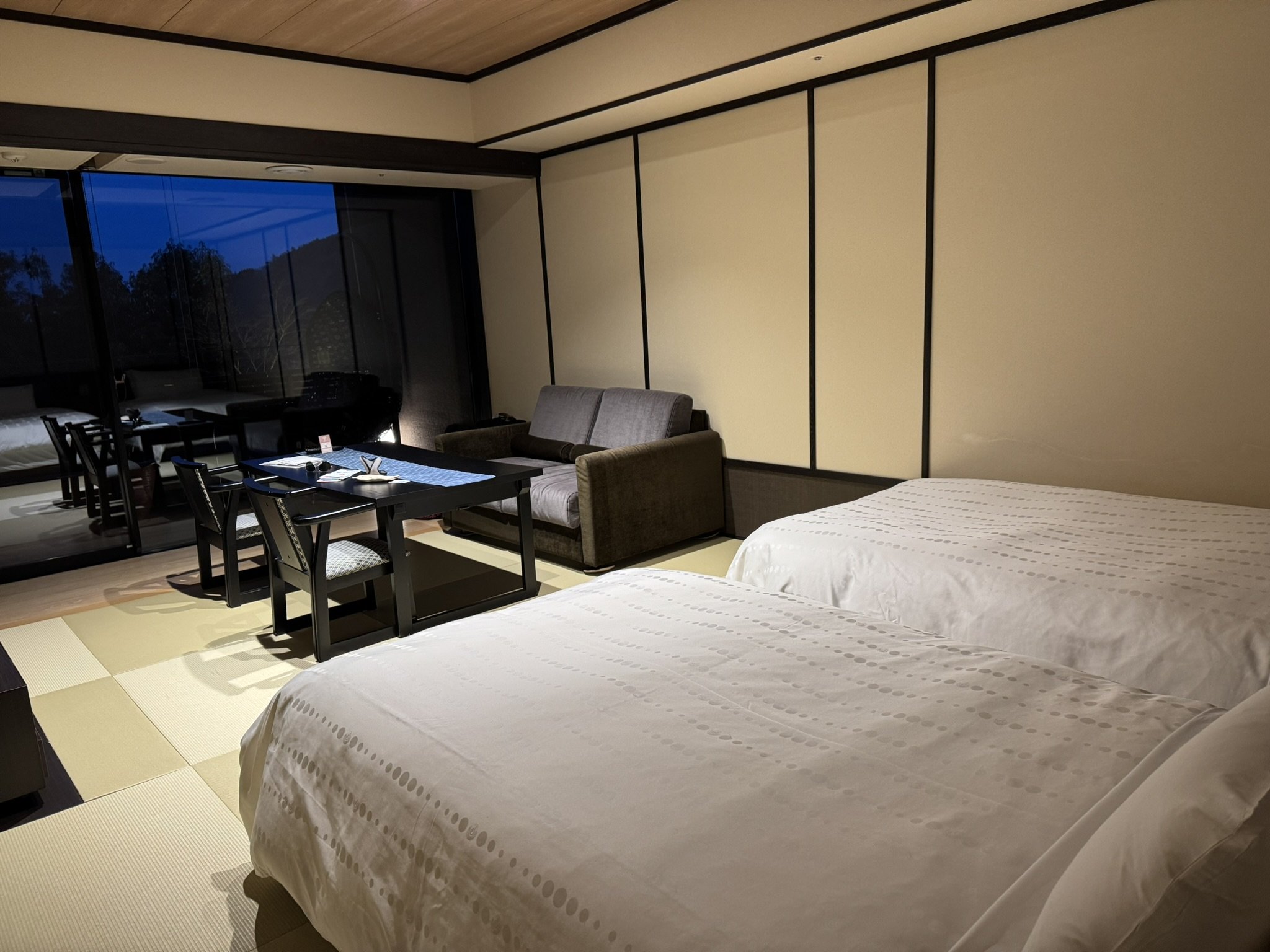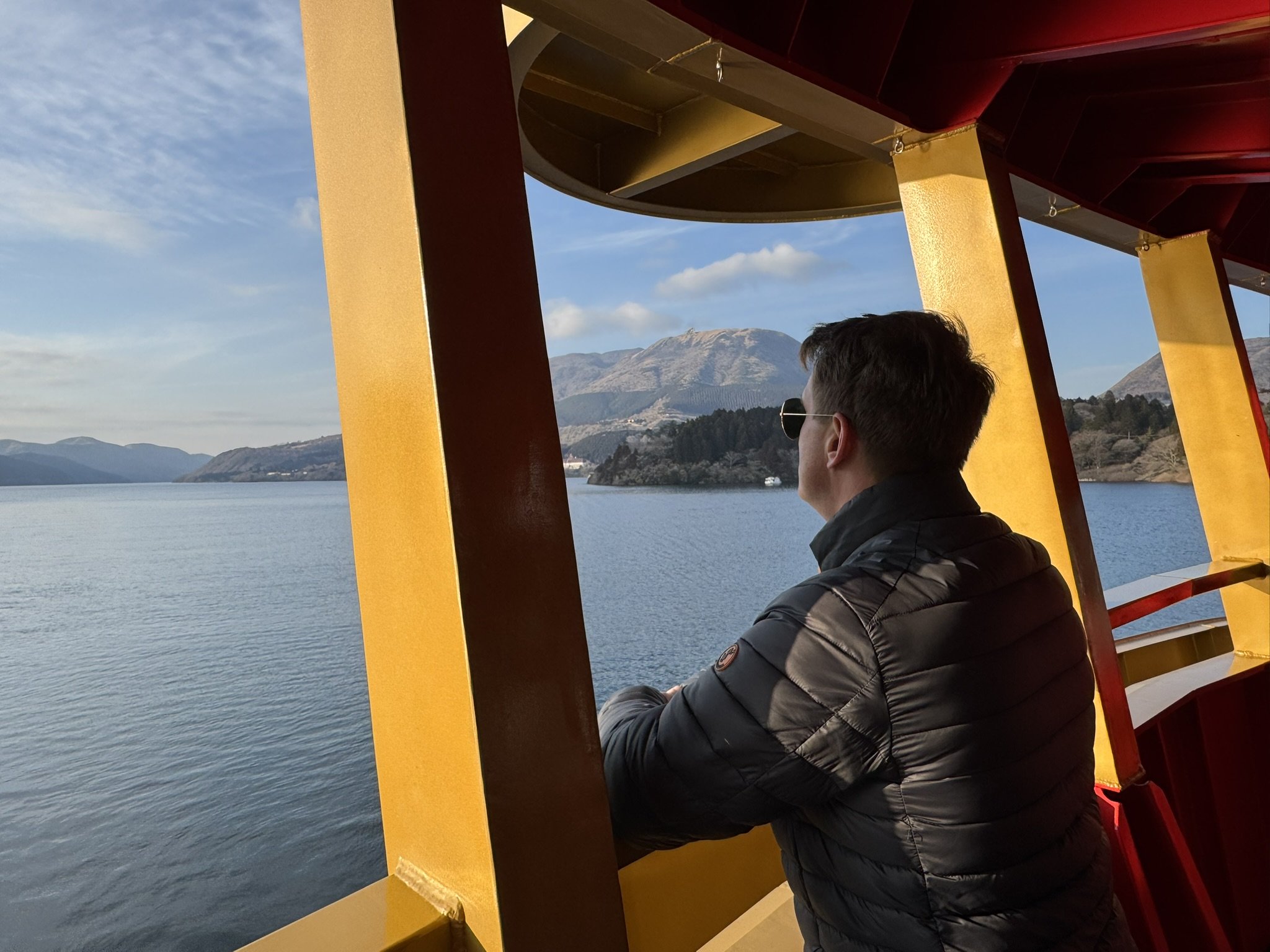48 Hours in Hakone, Japan: Spas, Scenic Views & Soothing Vibes
Lake Ashi Peace Torii
Hakone feels special. If you’re looking for a relaxing Hakone itinerary with onsens (hot springs), breathtaking mountain views, and tranquil lakeside strolls—this Hakone travel guide will help you make the most of your time in 48 hours. Just two hours from Tokyo by train, this hot spring town in Kanagawa Prefecture is a popular day trip from Tokyo, but it’s even better if you can stay overnight. Whether you’re soaking in a traditional onsen, cruising across Lake Ashinoko on a pirate ship, or gazing at Mount Fuji from a mountaintop—Hakone is 48 hours of magic you won’t forget.
We traveled to Hakone via the limited express Romancecar on the Odakyu Railway (note: there are two different train companies in this area!). This slower paced but spacious train was perfect for traveling to Hakone and we caught some great views of Mount Fuji along the route! Leaving the modern, futuristic, and mega-city of Toyko for the wooded mountains and lakes of Hakone is a complete change and total 180. The visit to Hakone allowed us to slow down, relax, and take in the natural beauty of Japan. One of our favorite parts of our trip was soaking in the hot springs staring at a waterfall with snow still on the ground (we visited in Mid-March). It was an unforgettable experience. We hope this guide inspires you to visit this region for a day trip or a few days and experience Japanese onsen culture!
First time to Japan? Check out our First Timers Guide to Japan! Interested in learning more about what apps you should download before heading to Japan and Hakone check out our Looking for Essential Apps you should download before heading to Japan post!
Why Visit Hakone?
Hakone blends traditional Japanese culture with natural beauty and spa-like relaxation. From rejuvenating hot springs to contemporary art museums in the forest, it’s the perfect getaway from Tokyo's urban buzz. Whether you're a culture seeker, nature lover, or just need a wellness reset, Hakone has something soothing to offer. Come visit if you are looking for a reset — slow down and enjoy a different side of Japan.
Lake Ashi
Helpful Hints for Visiting Hakone
Fun Fact: Hakone is one of Japan’s most famous hot spring towns, known for its natural onsens, mountain views, and art museums—and it’s only two hours from Tokyo.
Getting Around: The Hakone Free Pass is your best friend—it covers local buses, trains, ropeways, boats, and even the pirate ship. Start from Shinjuku Station for a seamless trip.
Weather & Packing: Hakone is mountainous and cooler than Tokyo. Mountain weather can shift quickly. Bring layers, a light jacket, comfy walking shoes, and a small hand towel for onsen visits.
Safety Tips: Hakone is very safe but do check for volcanic activity updates in Owakudani before heading out. Increased activity is rare but can happen — the last evacuation was in 2015 following a small eruption.
Population: Around 12,000 residents spread across several small villages—expect a calm, peaceful vibe with stunning nature all around.
Unique Fact: Hakone’s black eggs (Kuro-tamago) are boiled in volcanic hot springs in Owakudani. Legend says eating one adds 7 years to your life!
SIM Cards & Wi-Fi: Pocket Wi-Fi or eSIM works best. Cell signal can drop in mountain or forested areas, so don’t rely on free Wi-Fi. We highly recommend using Airalo as an eSim option! We used it throughout Japan and it worked great!
Entrance Requirements: Just like the rest of Japan—no special visas required for short-term tourism (up to 90 days for most nationalities).
Cash or Card? Cash is still preferred in small restaurants, buses, and shops. Most ryokans and hotels accept credit cards. Be sure to bring plenty of Yen. We recommend this travel-friendly money belt that is also RFID blocking.
Tap Water? Yes—safe, clean, and drinkable throughout Hakone. Don’t forget a reusable water bottle!
Restaurant Reservations? Yes, especially for dinner! Many spots close early or have limited seating, especially outside main towns like Gora or Hakone-Yumoto.
Plug Type: Type A/B (same as U.S.), 100V. Most devices work without a converter.
How to Get to Hakone from Tokyo
Hakone-Yumoto Station
There are a few different ways to get to Hakone. If you just want to get a quick taste of the region and see Mount Fuji without staying overnight, you can easily take a day trip from Tokyo. While this is a great option if you are short on time, if you have more time, we would recommend staying for at least a night or two to really experience the area. If traveling during a day trip you will most likely rush around to see Mount Fuji, take the pirate ship across lake Ashinoko, and see a few toriis (Japanese gates), shrines, and small towns. Our favorite part was taking the time to relax and enjoy the onsen (hot spring experience).
If you are traveling on your own, there are two main ways to get to Hakone — both by train. This can get confusing so we will try to simplify. There are two main train companies that bring you to the Hakone area:
If you are using the JR Rail Pass, the company that operates these trains is the JR Tokaido line. The JR Tokaido Line will take you to the larger station outside of Hakone to the town of Odwara. From Odwara you can catch public transportation into the different towns. If you take the JR Tokaido Line in, you will then have to use a different company (that normally does NOT take the JR Rail Pass) to get around the region. While this can be confusing and slightly frustrating, the easiest way to think of this is if you booked a flight on Delta Airlines and then tried to use your Delta Airlines ticket for a United flight. While they may look the same they are operated by completely different companies.
The easiest way to get to and around Hakone is to go through the Odakyu Railway and purchase the Hakone Freepass. Note: the Hakone Freepass is ONLY for local transportation AROUND Hakone - and does not include your train ticket to GET TO Hakone from Tokyo). So, you will need a long distance train ticket to get to Hakone and then a local pass to get around Hakone. While this does sound confusing, once you understand that these are two different tickets it makes things a lot simpler (we did not realize this and spent an hour at the train station trying to figure this out).
Japan sometimes takes a slight learning curve. If you want the easiest method and the one that we took, we recommend buying the Odakyu Railway Romancecar to Hakone AND purchasing the Hakone Free Pass (48 hours or longer if you plan to stay longer). The Hakone Freepass gives you access to all of the public transit in the region (with a few exceptions) - so this includes the buses to get around, the cog train at Gora Station, the Hakone sightseeing cruise (AKA the pirateship that takes you around the lake), the ropeway ( cable car that takes you over the mountain), and the local express train. If you are planning on visiting around Hakone we highly recommend getting the Hakone Freepass as it just makes things so much easier to get around.
Short Version: Buy a ticket for the Romancecar AND buy a ticket for the Hakone Freepass - this will make your trip simple, easy, and fun!
For an easy way to purchase a digital Hakone Freepass - consider buying through Klook
Pro Tip: When taking the train from Tokyo to Hakone, choose a seat on the right side of the train for view of Mount Fuji.
Best Time to Visit
View of Mount Fuji from the train
Hakone’s mountain climate is cooler than Tokyo year-round, with crisp mornings and evenings—perfect for soaking in an outdoor onsen.
Spring (March–May): 8–18°C (46–64°F) – Cherry blossoms, mild days, cool nights.
Summer (June–August): 18–26°C (64–79°F) – Warm but not sweltering; expect some rain in June/July.
Fall (September–November): 10–20°C (50–68°F) – Gorgeous autumn foliage, sweater weather.
Winter (December–February): 2–10°C (36–50°F) – Cold but clear—best time for snow-capped Mount Fuji views. The plum blossom festival takes place in February in neighboring Odawara so this is a great time to enjoy the beautiful blooms outside of peak cherry blossom season.
Visit Time Recommendation
2 days (1 night minimum) is ideal. You can cover Hakone’s highlights with a well-paced itinerary, but if you love hot springs and slow travel, 2 nights lets you unwind even more.
If you are pressed for time and just want to get a taste for the region instead, consider booking a day trip from Tokyo like this one.
What to Pack for Hakone
A misty day at Lake Ashi
Packing for Hakone depends on the season, but comfort and layers are key. Here’s a Hakone packing list to keep you comfortable and camera-ready:
Light layers for cooler mornings– A fleece or pullover is always a good idea, especially if you are visiting in the Spring and Fall.
A good rain jacket for those drizzly days. Ash likes this one for women that will keep you dry and still looked stylish in photos.
Always pack comfy waterproof walking shoes—you’ll be on your feet a lot. If you prefer rain boots, Ash loves these boots - she wore them every other day in Japan and they were great on those frequently rainy days.
Compact travel umbrella – Fits in your day pack and handles Japanese drizzle. The Japanese LOVE their umbrellas. Everyone uses them at any chance of rain. There are stands outside of restaurants and stores and places may also offer bags to put your umbrella in to keep the floors dry.
Ash also packed a pair of quick-dry leggings for wandering - great for rainy days or hiking to the waterfalls. Matt loves his travel pants from Chubbies that are great for travel, dressing up, and hiking.
Onsen essentials: A small hand-sized towel for bathing prior to dipping in the hot springs, modesty/covering up, and to place on your head to keep you cool while in the hot springs (not to be placed in the hot spring water) and flip-flops for walking to the onsens (not to be worn in the bathing area)
Swimwear for public pools and resort style waterpark onsens for the whole family. (NOT for traditional onsens - it is considered unclean and rude to wear clothing including swimsuits into the relaxing hot springs - even for Konyoku or mixed-gender onsens. You will be unable to enter as this could introduce bacteria to the water.)
Reusable water bottle - Hakone tap water is delicious—use the "MyMizu App" to find water refill stations in Japan.
Portable charger– many attractions are outdoors, and charging spots are limited.
💡 If you’re continuing your trip after Hakone, check out our Complete First-Timer’s Guide to Japan for transit tips, etiquette, and cultural dos & don’ts.
48-Hour Itinerary in Hakone
Day 01: Explore Hakone’s Highlights
This day is all about soaking up the scenery and checking off iconic spots using your Hakone Free Pass. It’s a whirlwind, but so worth it!
Morning:
Take the Romantic Train from Tokyo to Hakone-Yumoto
Head to the Hakone Open-Air Museum in Gora
Grab lunch at Gora Brewery or a local soba shop
Afternoon:
Ride the Hakone Ropeway up to Owakudani
Try a black egg and enjoy the views of Mt. Fuji (on a clear day!)
Continue to Lake Ashinoko and board the Pirate Ship Cruise
Visit the Hakone Shrine and Peace Torii
Pro Tip: When visiting the Hakone Shrine, be sure to arrive early morning to avoid photo queues at the Peace Torii
Wander around Moto-Hakone for snacks and local crafts
Evening:
Check into your ryokan or hotel
Have a traditional kaiseki dinner (reserve ahead!)
Enjoy your first soak in an onsen bath under the stars
Day 02: Slow Down & Soak It In
This day is dedicated to relaxation and rejuvenation.
Morning:
Start your day with a peaceful morning onsen soak
Enjoy a traditional Japanese breakfast at your hotel
Visit Chisuji Falls (a gentle walk and serene experience)
Afternoon:
Treat yourself to a spa treatment or private onsen
Sip tea, read, journal, or just enjoy the mountain air
If time permits, visit the Pola Museum of Art or stroll Hakone-Yumoto shops for souvenirs
Evening:
Have a final soak before your journey back to Tokyo
Return feeling refreshed, relaxed, and deeply recharged
Hakone Onsens: What to Expect
Onsen Etiquette 101 (Read This Before You Soak!)
Experiencing a traditional onsen is a highlight of visiting Hakone, but there are some important customs to follow:
Shower first: Clean your body thoroughly before entering the shared bath.
No swimsuits allowed: Onsens are typically nude-only (separate male/female baths but there are also co-ed).
No towels in the water: Leave them on the edge or on your head to keep you cool.
Tattoos? Most onsens restrict entry or require tattoos to be covered so bring some flesh colored, waterproof patches with you. While many onsens accept tattoo cover-up patches, some may not allow them or may have specific rules about their use. It's always best to check with the onsen in advance.
Be quiet and respectful: Onsens are peaceful places to relax.
Pro Tip: If you’re unsure about public baths, book a private onsen (rotenburo) where you can relax solo or with a partner.
In-room onsen bath at the Hakone Kowakien Ten-yu
Where to Stay and What to Eat
🏨 Hakone Kowakien Ten-yu
Our pick! Nestled in the mountains, this luxury ryokan-style hotel has open-air infinity onsens with a view—yes, it's as dreamy as it sounds. Dinner and breakfast can be included when booking. The food is delicious, and the service is top-tier. This hotel has amazing onsens - separate male and female hot springs that are perfect for relaxing. We also had a private onsen in our room that was perfect for soaking early in the morning or late in the afternoon while taking in those beautiful mountain views.
💡 Other Lodging Options:
Gora Kadan - If you are looking for an upscale luxury ryokan consider the Gora Kadan. It blends timeless Japanese design in a beautiful setting with amazing mountain views. If you are looking for iconic, this is it.
Yumoto Fujiya Hotel - We were highly considering this one because of its convenient location right next to the Hakone Open Air Museum. Additionally, it has a great blend of traditional style with modern amenities.
Hakone Hotel - If you are looking for something more budget friendly located right near the lake, the Hakone Hotel is a great option. You are close to many shops and restaurants and several of the main sights in Hakone. This is a great option if you are looking for something more convenient with some absolutely amazing views.
While there are several restaurants in different areas to choose from - one that we highly recommend is the Gora Brewery. This brewery nestled near the Gora cog wheel station was one of our favorite meals while we were in Japan. The beer is great and the food is mouthwatering. They even have a small foot bath onsen with benches for relaxing outside with a beer! Be sure to stop here if you are in Hakone.
Final Thoughts
Hakone is one of those places that makes you reset and refocus. We absolutely loved the onsen experience and wandering around this beautiful region. It’s not just about the views or the spas—it’s about how relaxed, grounded, and connected to nature you feel when you leave. Whether you're sipping local beer in Gora, soaking in a steaming onsen under the stars, or snapping that perfect photo at the Peace Torii—Hakone feels like a deep breath in a fast-paced trip.
Take those 48 hours and let Hakone work its quiet magic. You won’t regret it.
Still feeling a bit overwhelmed about traveling through Japan? Check out our First Timer’s Guide to Visiting Japan!
Interested in learning more about what apps you should download before heading to Japan and Hakone? Check out our Looking for Essential Apps you should download before heading to Japan post!
Pirate ship cruise on Lake Ashi
Looking for more travel advice?
Explore more with these destination-based guides:
72 Hours in Tokyo – Iconic Landmarks, Food Tours & Hidden Gems
4 Days in Kyoto – Zen Temples, Geisha Alleys & Matcha Dreams
First Timer’s Guide for making the most of your trip to Japan!
Disclosure: This post contains affiliate links, which means we may earn a small commission (at no cost to you) if you book or purchase through our links. We only recommend things we’ve personally used and loved. Thanks for supporting our blog!
✨ Ready to plan your own Hakone escape?
Check prices for Hakone hotels or browse tours around Hakone to get started!
